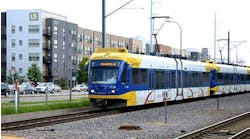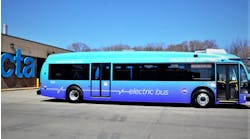The American Planning Association (APA) on Oct. 1 announced that Central Avenue in Hot Springs, Ark., has earned the designation as one of the 10 Great Streets for 2014.
Each October during National Community Planning Month, APA’s Great Places in America program names 30 exemplary streets, neighborhoods and public spaces that add value to communities and foster economic growth and jobs. APA’s Great Streets, Great Neighborhoods and Great Public Spaces feature unique and authentic characteristics that have evolved from years of thoughtful and deliberate planning by residents, community leaders and planners.
"Recognizing these special places highlights the role planning plays in adding value to communities," said William Anderson, FAICP, president of APA. "Planners, working with others, help build better communities in a variety of settings, from urban to rural; the result - better neighborhoods, cities, and regions. We applaud these efforts and congratulate this year’s designees."
Since Great Places in America was launched in 2007, APA has designated 230 neighborhoods, streets and public spaces. Places are announced annually and represent the gold standard in terms of having a true sense of place, cultural and historical interest, community involvement, and a vision for tomorrow.
New this year, APA is seeking input from the public for the “31st Great Place Designee.” Interested citizens can nominate their Great Place by commenting on APA’s Facebook page or via Twitter using hashtag #mygreatplace. The “31st Great Place Designee” will be announced on Oct. 31.
Central Avenue in Hot Springs, Ark.
Central Avenue is the main thoroughfare of downtown Hot Springs, Arkansas, which is named after the naturally thermal spring waters that flow from the ground at an average temperature of 143° F. Flanked on one side by historic Bathhouse Row, a handful of preserved Spanish Revival, Victorian and Greek Revival buildings, Central Avenue also boasts artisanal shops, art galleries, restaurants and museums. National park lands of the Ouachita Mountains slope steeply upwards on both sides of Central Avenue, stretching out for miles. The street twists and winds organically between the hills. Hot Springs draws approximately 23 million visitors each year, generating $6 billion in tourism revenue. The City adopted an update to its “Hot Springs 2030” plan in 2010, and in 2013, more than $40,000 in Community Development Block Grant funds were allocated to upgrade and restore existing building infrastructure. To learn more click here.
In addition to Central Avenue in Hot Springs, Arkansas being designated a great street, the following nine other streets were also recognized:
5th and 6th Avenues at Portland Transit Mall in Portland, Ore.
The Portland Transit Mall in Portland, Oregon, is a 1.2 mile couplet of one-way streets - 5th and 6th Avenues - that lie at the cultural and economic center of Portland. Originally opened as a bus transit corridor along 22 blocks in 1978, the Portland Transit Mall was born from Portland’s 1972 Downtown Plan, which had the simple but firm vision that parking should be restricted, transit should be enhanced and downtown should be a pleasant place to work, live, play and visit. A 14-block extension was added north to Union Station in 1994, and the Portland Mall Revitalization Project in 2009 included an 18-block extension south to Portland State University, the renovation of the existing mall and an addition of light rail. Today, more than 60,000 transit riders pass through the Mall on an average workday.
25th Street in Ogoden, Utah
25th Street in Ogden, Utah, serves as the town's commercial thoroughfare and features the most complete contiguous selection of turn-of-the-century commercial architecture in the state. But the history of the town and its development are the source for Ogden's mystique. Ogden was chosen to be the junction city of the Union Pacific and Central Pacific railroads in 1874. The street became known as “Notorious 25th Street” due to its constant activity, particularly gambling, opium dens, bootlegging and brothels. Presidents Taft, Hoover and Theodore Roosevelt, along with "Buffalo Bill" Cody were among the celebrities known to visit the street. The decline of rail service led to the decay of 25th Street in the 1950s and 60s, when property owners and the Junior League began to organize a Historic Preservation Committee. The 25th Street Master plan in 1977 was followed by a Listing on the National Register of Historic Places in 1978 and a 25th Street redevelopment district was created in 1979. Today, 25th Street draws crowds with its local restaurants, merchant displays, amphitheater and variety of year-round events. Situated at the base of the Wasatch Mountains, the city has also become a Rocky Mountain hub for the outdoor industry. Construction is also underway for pedestrian, bike and additional transit connections.
Broadway in New York
The 14-mile stretch of Broadway in New York City cuts across the city's grid system, creating a series of Squares - Union Square, Madison Square, Herald Square and Times Square among them - which have unique personalities, define neighborhoods and remain centers of activity day and night. Originally a Native-American footpath that traversed the length of Manhattan, Broadway was completed at the end of the 19th century. The 1811 Commissioners Plan, which put the dominant grid system plan in place, were unsuccessful in their attempts to straighten Broadway above 14th Street, challenging future traffic engineers and planners with improving motor vehicle traffic and pedestrian circulation along the corridor for decades. More recently, the New York City Department of Transportation implemented two transformative projects along the Broadway Corridor, closing it to vehicular traffic and converting the street into pedestrian-only plazas for walkers, cyclists and those lounging in temporary seating. The project has been widely successful and has since been made more permanent by expanding throughout other portions of Broadway.
Clematis Street in West Palm Beach, Fla.
The shops and restaurants that occupy the ground floor spaces in the historic buildings along Clematis Street in West Palm Beach, Florida, serve as the dining, retail and entertainment options for the startup businesses, small tech companies, creative office industries, and artists that occupy the spaces above. Serving as the commercial district for West Palm Beach since the 1890s, Clematis Street has become an eclectic and authentic display of nearly every significant architectural era and style of the last 115 years. A waterfront park and pavilion opened to the public in February 2010, preceded by a new library and City Hall complex that replaced a vacant old building. Both of these projects followed a 2007 update to the Downtown Master Plan, which created a conservation district to preserve the existing character and scale of Clematis Street. The street was converted back to a two-way street in the early 1990s and safety and aesthetic improvements were made such as planting the iconic palms. The 500 block of Clematis Street was listed in the National Register of Historic Places in 1996.
Congress Street in Portland, Maine
Congress Street in Portland, Maine, serves as the city's primary east-west commercial and transportation axis. Dating back to the Revolutionary War, Congress Street features a mix of historical architectural styles, from 18th century Colonial, 19th century Federal to 20th century International and 21st century Post Modern, with examples of nearly every significant style of residential, commercial and civic architecture in between. Home to numerous art galleries, theaters, museums and schools, Congress Street benefited from federal urban renewal money in the 1970s that led to the rehabilitation of many of the street's buildings over the next few decades - including The State Theater, Portland Museum of Art and The Children’s Museum of Maine – and provided upgrades to the street lighting and street furniture in order to attract new business. More recently, Community Development Block Grant (CDBG) funds totaling $90,000 were allotted to façade improvements for three buildings along Congress Street in 2013, which property owners matched dollar-for-dollar.
King Street in Charleston, S.C.
King Street in Charleston, S.C., is the spine of this historic city, connecting Charleston Harbor to uptown. Known for its Southern charm, the street bustles with activity around the clock thanks to the College of Charleston, which is a few steps away, and nearly 4.8 million visitors annually. The revival of King Street began in the mid-1980s with the Charleston Place Hotel and shops, which were constructed with Federal Grants including a $10 million Urban Development Action Grant and $4 million from the Economic Development Administration. The Charleston Downtown Plan, which focused on both business and residential areas, was adopted in the late 1990s, followed by a $20.5 million streetscape project that was implemented in three phases over nine years. Today, King Street is divided into three distinct districts, with Upper King being the Design District, Middle King the Fashion District and Lower King the Antique District. Adjacent to Upper King is Marion Square, the 10 acre park that hosts large annual events including Charleston Fashion Week, Southeastern Wildlife Festival and the Charleston Food & Wine Festival, as well as the weekly City of Charleston Farmer’s Market, named one of the nation's 10 best by Travel and Leisure Magazine.
Main Street in Sag Harbor, N.Y.
First established in 1745, four years before it was selected over New York City to become the first U.S. official port of entry, Main Street in Sag Harbor, N.Y., is a nine-block, cosmopolitan meeting place for village officials, business owners, residents and visitors going to work, doing errands, shopping, getting coffee, eating or simply people-watching. Today, more than 40 years after it was designated as a national historic district, Main Street still showcases the last vestiges of its whaling industry, which is how the village served the country during wartime. Lately, community leaders and residents have taken to raising funds to refurbish some of the street's historic mansions into functional retail spaces for commercial use. The result is an unmistakable aura of old wealth, culture and history.
Pennsylvania Avenue in Washington, D.C.
Pennsylvania Avenue in Washington, D.C., is often called “America’s Main Street” due to its symbolic role in the country's development. Since the first inaugural parade down Pennsylvania Avenue in 1805 to celebrate Thomas Jefferson’s second inauguration, Pennsylvania Avenue has been the site of many historic events, including presidential inaugurations, state funerals, protests, marches and celebrations. Pennsylvania Avenue has also served as the backdrop for the fights for workers’ rights, women’s suffrage and civil rights. The original L’Enfant Plan in 1791 called for Pennsylvania Avenue to serve as a one-mile “grand avenue” to connect the “Congress House” to the “Presidential Palace.” While the visual connection between the White House and the Capitol was interrupted by the construction of the Treasury Building, the view of the Capitol has been preserved and enhanced by the buildings on either side which are significantly set back from the street. Today, Pennsylvania Avenue contains a mix of civic spaces, public buildings, monuments, parks, local government, residences, hotels, theaters and museums.
State Street in Santa Barbara, Calif.
State Street has served as the social, economic and cultural center of Santa Barbara, Calif. and the southern coast for over 150 years. Its unique Hispanic architectural style and landscaping, pedestrian amenities, proximity to the Pacific Ocean, incredible views of the Santa Ynez Mountains and cultural sites provide 24-hour activities for residents and visitors. Since the 1960s, the city has invested in projects to re-energize the street, such as widening sidewalks, providing a strong retail core environment, increasing support for the arts, banning street parking, creating off-street parking and providing an electric shuttle bus program. More recently, the $8 million State Street Beautification Project completed in four phases replaced sidewalks, crosswalks and landscaping. This year, Old Spanish Days, a cultural parade with educational events along State Street, will celebrate its 90th anniversary. The Santa Barbara International Film Festival, which draws celebrities, fans, industry professionals and guests to the theatres of State Street for movie premieres each year, will celebrate its 30th anniversary in 2015.


